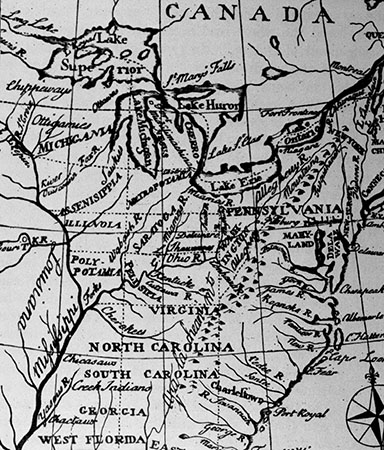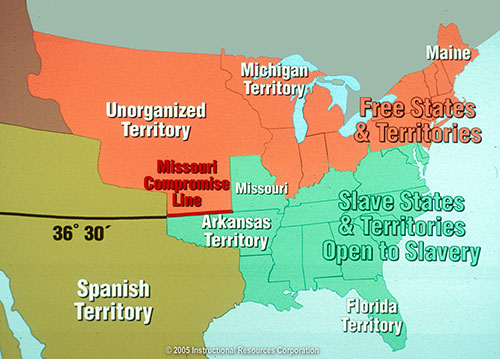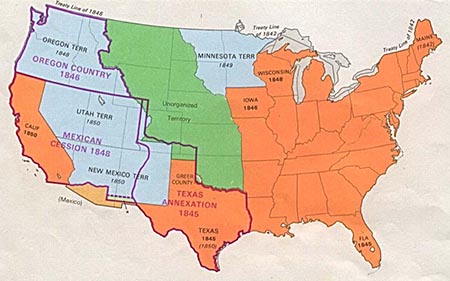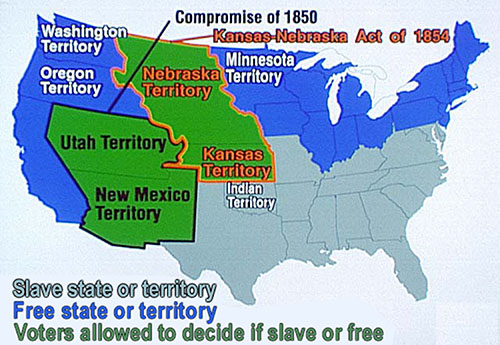Learn
Compromises
As we've discussed, northern states feared the expansion of slavery would give the South an advantage in Congress, but they also believed Congress had the power to prohibit slavery in new states. On the other hand, if Congress had the power to end slavery anywhere, the southern slave states feared this power could threaten their slave-based economy. Maintaining a balance of free and slave states was important because it balanced representation in the United States Senate.
Northwest Ordinance of 1787
As a refresher: The Northwest Ordinance of 1787 was passed under the Articles of Confederation. It forbade slavery in the Northwest Territory. This made the Ohio River a natural dividing line between free and slaves states. It said:
"Article 6. There shall be neither slavery nor involuntary servitude in the said territory, otherwise than in the punishment of crimes whereof the party shall have been duly convicted: Provided, always, That any person escaping into the same, from whom labor or service is lawfully claimed in any one of the original States, such fugitive may be lawfully reclaimed and conveyed to the person claiming his or her labor or service as aforesaid."
Slavery had been creeping into the Northwest Territory, even though the Northwest Ordinance of 1787 prohibited slavery there. For years, slave owners moving into the Northwest Territory had taken their slaves into the area under the guise that they were indentured servants
Remember that an indentured servant is a person that agrees to work for another for a specified time in return for payment of travel expenses and maintenance.
.

However, new states formed north of the Ohio River were free states.
Admitting New States
During westward expansion and new land purchased or won, eventually new states were formed. Beginning with land from the Louisiana Purchase, the free states and slave states disagreed over how those new states would enter the Union.
When Alabama became a state in 1819, there was an equal number of slave and free states, which provided a balance of power.
Missouri, which was part of the Louisiana Purchase, applied for statehood in 1819 as a slaveholding state. This application to enter as a slave state would upset the balance between free and slave states. Maine, which had been a part of Massachusetts, was also seeking statehood.
President James Monroe sought a compromise.
The Missouri Compromise of 1820
Congressman James Tallmadge of New York proposed two amendments to Missouri statehood. These amendments prohibited taking slaves into Missouri and provided for the gradual emancipation of the slaves already residing in Missouri.
The United States House of Representatives passed the bill, while the Senate rejected it. Both chambers voted on sectional lines. Remember, House representation is based on population, while Senate representation is equal for every state. Because there are equal numbers of senators from slave states and free states, their votes were even. The House, which had more members from free states, refused to pass the bill now that the Senate had rejected Tallmadge's anti-slavery amendment to the bill granting Missouri statehood.
After this stalemate, Missouri renewed its application for statehood in late 1819. This time, Speaker of the House Henry Clay (called the Great Compromiser) proposed a compromise known as the Missouri Compromise of 1820 that included the following provisions:
- Missouri would be admitted as slave state.
- Maine would be admitted as a free state.
- All new states from the former Louisiana Purchase lands north of an imaginary line drawn at 36° 30' latitude (which ran along Missouri's southern border) would be admitted as free states when applying for statehood.
Senator Jesse B. Thomas of Illinois added the amendment that banned slavery in the rest of the Louisiana Purchase territory north of latitude 36° 30', but Henry Clay was given credit for the proposal.
Read The Missouri Compromise for how this compromise affected African Americans and led to slave rebellions.

Slave States and Free States
It seemed to be a good idea to admit states in pairs – one free and one slave – thus keeping free and slave states equal in number. Here are the states admitted as free states or slave states after 1812.
| Free States | Year | Slave States | Year |
|---|---|---|---|
| Indiana | 1816 | Alabama | 1817 |
| Illinois | 1818 | Alabama | 1819 |
| Maine | 1837 | Missouri | 1821 |
| Michigan | 1838 | Arkansas | 1836 |
| Iowa | 1846 | Florida | 1845 |
| Wisconsin | 1848 | Texas | 1845 |
After 1848, all states were admitted as free states.
Hindsight tells us the Missouri Compromise was only a temporary solution, merely delaying civil war. It provided forty years of peace but also forty more years of slavery.
Sectionalism
Tariffs
The slavery question was a key point in the development of sectionalism. However, there was another issue that threatened to cause sectionalism: the issue of tariffs which led to a debate over states' rights.
We discussed these tariffs in a previous unit. Need a refresher?
The first major act under the United States Constitution was the Tariff Act of 1789, which gave the federal government the ability to raise money to pay off debts. Throughout the 1800s, tariffs rose and fell depending on which party was in power.
In 1828, a tariff on imported If an item is imported that means it is brought in from another country to be used, sold, or processed. products was passed, which provided some protection for domestic products because it was a tax An income tax was declared illegal in the Constitution, so no one paid tax on their income in the nineteenth century, unlike today. on imported products. The federal government approved of this method to generate money and protect domestic products.
Southerners alleged the tariffs were unconstitutional because it only applied to agricultural and not industrial areas. Southern states objected to the increased tariffs because they were prominent producers of cotton and raw materials which were bought by other countries, so a high tariff harmed their sales.
Henry Clay's American System supported higher tariffs and the Tariff of 1832 was passed despite loud and long objections from the southern representatives. Clay and his Whig Party led the debates in favor of higher tariffs. Southern Democrats led by John C. Calhoun debated for lower tariffs.
Nullification Crisis
Southerners objected and South Carolina voted in a state legislature vehemently opposed to the tariff. Read The South Carolina Nullification Controversy to learn how the 1828 tariff affected the northern and southern states and how each felt about it.
The South Carolina Ordinance of Nullification was enacted into law on November 24, 1832. As far as South Carolina was concerned, there was no tariff. President Jackson asked Congress to enact legislation permitting him to use federal troops.
Henry Clay revised the tariff with a compromise bill.
Another Compromise
The Missouri Compromise of 1820 defused sectionalism for only a short time. In the next decades, the issue of slavery seems to keep coming up and sparking the flame of sectionalism. There were four important issues at this time:
- Vast territory had been added to the United States as a result of the Mexican American War.

On this map, Mexican Cession is shown in white and the Gadsden Purchase in brown. See larger version of map of the United States after the Mexican-American War here. - California's population had exploded with the 1849 Gold Rush and California had recently petitioned Congress for statehood as a free state. California entering as a free state would upset the balance of free and slave states.
- Texas land claims were vast and questionable. Texas claimed territory all the way to Santa Fe! Not only was it big, it was a slave state. To the abolitionists, it was way too much slave territory, especially since some of the claims were north of the Missouri Compromise line.

See larger version of the map of US territorial growth by 1850 here. - Washington D.C. was home to the largest slave market in North America. To the growing number of abolitionists – including members of the Underground Railroad and free African Americans – having this slave market in our nation's capital was an atrocity.
The plan was to pass bills addressing these four issues and keep the nation united. Let's look at the major players in the Compromise of 1850.
- Henry Clay: The 70-year-old "Great Compromiser" and Kentucky senator presented a compromise on January 29, 1850.
Some interesting facts about Clay:
- Clay unsuccessfully ran for president three times. He once said, "I'd rather be right than president."
- He is credited with delaying civil war "until the union could survive it."
- He was the first person to be laid in state To place the coffin on view to allow the public to pay their respects to the deceased. in the US Capitol building rotunda.
- Daniel Webster: This 68-year-old senator from Massachusetts was called the "Great Orator" and he led the debate in support of the Compromise of 1850.
Some interesting facts about Webster:
- Webster once said, "Keep cool; anger is not an argument."
- He ran unsuccessfully for president three times.
- Webster was personally opposed to slavery and had previously fought the expansion of slavery. He abandoned this opinion in order to support this compromise because he felt that saving the Union was more important than any other issue.
- He died of a head injury after falling from his horse.
- Stephen A. Douglas: This 37-year-old senator from Illinois broke Clay's original omnibus billA bill that covers many topics
into individual bills. This allowed congressmen to vote or abstain
sit out a vote; not cast a vote either for or against
on each separate topic, which helped to pass the Compromise of 1850.
Some interesting facts about Douglas:
- Douglas has several connections with Abraham Lincoln. Douglas once courted Mary Todd, who later married Lincoln.
- Lincoln defeated Douglas for the presidency in 1860.
- Douglas held Abraham Lincoln's hat and cane at Lincoln's inauguration.
- John C. Calhoun: Known as "Cast Iron Man," this 68-year-old senator from South Carolina was opposed to the Compromise of 1850, calling it a blow to states' rights. He demanded federal protection of slavery in order for the South to remain in the Union.
Some interesting facts about Calhoun:
- Calhoun resigned as vice president in 1832, which has only happened one other time.
- He believed slavery was a positive good.
- His last speech in the Senate was on this compromise and given by proxy because he was too ill to speak. He died a few weeks afterwards.
- Calhoun once said, "In looking back, I see nothing to regret and little to correct."
By 1852, Clay, Calhoun, and Webster had all passed away, with their work on the Compromise of 1850 being some of their last big political accomplishment. You can read Three Senatorial Giants: Clay, Calhoun, and Webster to learn more about them.
Here's how the four main issues were addressed by the Compromise of 1850.
| Free States Receive | Slave States Receive | Issues Addressed |
|---|---|---|
| California admitted as a free state. | New Mexico, Nevada, Arizona and Utah Territories could decide slave status when they applied for statehood. | #1: Vast territory acquired due to Mexican cession. #2: California statehood as free state. |
| End of slave trade in Washington, D.C. | Slave allowed in Washington, D.C. | #4 Slavery and slave trade in the nation's capital. |
| Texas lost boundary dispute with Mexico. | Texas gets $10 million to pay debt to Mexico | #3: Texas Land Claims |
| Senate +2 votes for free states. (California) | Fugitive Slave Law was passed to pacify slave states due to imbalance in the Senate. | #2: Texas admitted as slave state. |
Fugitive Slave Act
Also as part of the Compromise of 1850, the Utah and New Mexico territories (as they were south of the 36° 30' latitude) were allowed to vote on whether slavery would be allowed in their areas. This resulted in the majority of the Senate voting power to now be in the hands of the free states. To correct some of this imbalance, a Fugitive Slave Act was also passed. It stated that law officials were responsible for scathing runaway enslaved people and return them to their owners.
The most controversial part in the Compromise of 1850 was the strengthening of the fugitive slave laws, many of which had been around since the colonial days. Read The Compromise of 1850, focusing on the section about this act. We will learn more about this act later in this unit.
